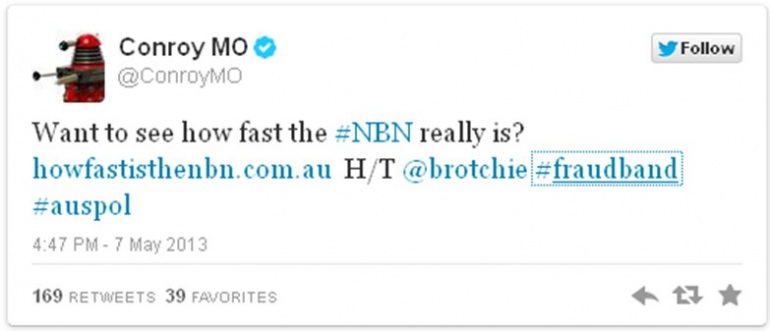A high-speed broadband accident
How to explain the following tweet from Senator Conroy’s office this week?

The website linked to is inaccurate and intended to mislead. Senator Conroy’s new online best friend starts out by quoting Tony Abbott as saying he’s confident 25 megabits per second will be enough bandwidth for an average household. Labor and its apologists are attempting to twist this remark into something it is not, and present it as meaning the Coalition’s NBN will have a maximum download speed of 25 megabits per second.
That is simply untrue. Under fibre to the node or FTTN (the type of network the Coalition has proposed for about 7 in 10 premises) most households and businesses can obtain download data rates of 50 megabits per second or better, and upload data rates at least a quarter of that. And technology is not standing still. The latest technique for more bandwidth over copper, vectored VDSL (which Deutsche Telekom last month announced it would roll out to tens of millions of households) is already capable of download rates of 50 megabits per second at a distance of 800 metres from the node (about the maximum line length under a Coalition NBN’s FTTN).
Our target of universal access to minimum download data rates of 25 megabits per second by 2016 is just that – a basic benchmark for what we assume every household and business should at least have access to by then. Labor’s NBN shares the same view of where this floor should be, since this is the download rate the NBN satellite and fixed wireless networks contracted under the current government will offer to 1.5 million Australians living in regional and remote areas.
What are the bandwidth needs of an average household? Well, first keep in mind upload and download “speeds” are actually a description of the rate at which data can be transmitted over a link – in essence, a measure of the size of the pipe.
Also keep in mind that a quarter of Australian households have one person, and a third two persons; according to the 2006 Census fully 58 per cent of the nation’s households were made up of two or fewer people. And don’t forget 25 megabits per second supports streaming FOUR HD video programmes in parallel. Likewise, a connection providing 5 megabits per second uploads and 25 megabits per second downloads would permit two simultaneous SD video conferences.
So those two people in a third of households won’t even have to speak to one another, much less watch the same TV programs. While there may well be a number of such households that want (or even need) more bandwidth, a clear majority are likely to be quite well-served by a 25 megabit connection for years to come.
In any case it cannot credibly be claimed 25 megabits per second is the end of the road, the limit of Coalition ambitions. After all, we have clearly stated:
- NBN Co will be asked to increase download date rates to at least 50 megabits per second across at least 90 per cent of the fixed line footprint by 2019, two terms of Parliament from now.
- NBN Co will design and build all parts of its fixed network with an expectation of future upgrades (whether extending fibre to the premises or to some other point beyond the node) in mind.
- We want NBN Co to provide opportunities for local communities, councils or state governments, infrastructure firms and other investors to co-fund FTTP rollouts: offer to pitch in half the cost of extending fibre to every premise, if this is seen as desirable prior to any sign of economic demand for FTTP in the broader market, and NBN Co will quite probably do it.
- NBN Co will be asked to offer fibre on demand to individual premises, a service we expect will be of interest to data-intensive small businesses operating in residential areas and prepared to incur the likely capital cost of several thousand dollars.
But let’s return to our friends at http://howfastisthenbn.com.au/ and list the most obvious of the half-truths and falsehoods.
The claim is made that for FTTP “no power or ongoing maintenance is required.” Both are wrong. Power plainly is required at the customer’s premises (where it powers equipment owned by NBN Co, but users pay the bill). That is why one of the devices the NBN Co installed in your house – if you are among the tiny handful to have an activated connection – is a Power Supply Unit with backup batteries to keep your connection alive in case of a blackout.
Equally false is the claim no maintenance is required on FTTP. What a joke – have Senator Conroy’s friends ever spoken to a telecommunications carrier? Are fibre optic cables immune to shovel strike? Are fibre distribution hubs, the NBN Co’s street cabinets, impervious to trucks backing over them or vandals setting them alight? Has human error been abolished so that all fibre splices are perfect? Maintenance is an issue with every network, everywhere.
Next, the site purports to compare the download and upload speeds of FTTN and FTTP. But it does so by choosing the minimum data rates the Coalition has set for FTTN with the maximum (and not to be deployed for almost a year) data rates promised by FTTP. The two products will be hundreds of dollars apart in cost. But don’t let’s worry about trivial details like that – remember all of this is FREE!
Except that it’s not – on the contrary, Labor’s NBN is systematically verifying the truth of the adage that there is no such thing as free. At present the proposed wholesale ‘AVC’ (or access) charge for 1000/400 megabits per second is $150 a month or $1800 per year. Adding RSP costs and margin on top of that will result in a retail charge to the user of around 1.9 times that figure. For 25/5 megabits per second the AVC is $27 a month.
NBN Co also charges separately for data volumes with its ‘CVC’ charge. This is going to be more costly than you might anticipate on a 1000/400 megabits per second service – after all, why purchase so much download capacity if you’re not going to use it?
Well, if the proud owner of the 1000/400 megabits per second connection detailed on the website limited herself or himself to 30 minutes of peak capacity download usage per day, the wholesale CVC charge over the course of a year directly attributable to this single customer would come to $4900 – or about $410 a month. Ouch.
After all running a 1 Gbps connection at full speed for half an hour would enable you to download 225 GB – that is a hundred or more two hour feature films. Do that every day for a month and you will have downloaded nearly 7 Terabytes or the equivalent of more than 3000 feature films or put another 6,000 hours of viewing which is more than months of continuous viewing (no sleep allowed).
If we add the AVC and CVC wholesale charges incurred by the 1000/400mbps account, and multiply by 1.9 to reflect retail overhead and margin (which in this case would be substantial, because of the vast costs of backhaul for this customer) then the total bill the lucky owner of this splendid connection will be up for over a year will be $12,700 – or about $240 per week. That may well put a whole new spin on uploading your wedding pictures in 0.7 milliseconds. It also casts fibre on demand in a different light.
Nothing is wrong with all of this. Price discrimination is an efficient way of making capital-intensive infrastructure viable. But when the Coalition makes the completely unremarkable claim that these high-end users might want to front load costs via a ‘fibre on demand’ product – and avoid imposing deployment costs on everyone else in the community who doesn’t need fibre yet – we are told we are creating a digital divide.
NBN Co assumes hardly any users will need the 1000/400 megabits per second product until the second half of this decade, and it is priced accordingly. Less than 5 per cent of users will elect to take up this service by 2028 – compared to over a third of users who will choose upload speeds of 1 megabit per second.
Yet the website’s comparison is not simply misleading, it is inaccurate. Download and upload rates depend on many factors – line speed between the premise and exchange, line speed and contention further up in the network, the server at the other end of the transaction – and is always limited by the slowest link along the overall path from point A to point B.
The debate about FTTP and FTTN is about time and money. Our concern with near-universal FTTP is that it is costing far too much and taking far too long. If people don’t care about the money, think of the time. The NBN Co will struggle to meet 15 per cent of its June 30 rollout target, and be around 2 per cent finished at that date. The 2 million or so premises that couldn’t watch a YouTube video in 2007 still can’t. After six years of Labor, NBN Co has fewer than 20,000 users on its fibre network.
We should be focused on giving priority to people who may otherwise wait ten or more years for ANY broadband, not on the selfish (but no doubt inestimable) joy and thrill of being able to download movies in seconds. Oh, and by the way, who was it that said it was always the Coalition turning the conversation about the NBN into a trivial discussion of movie downloads?
















